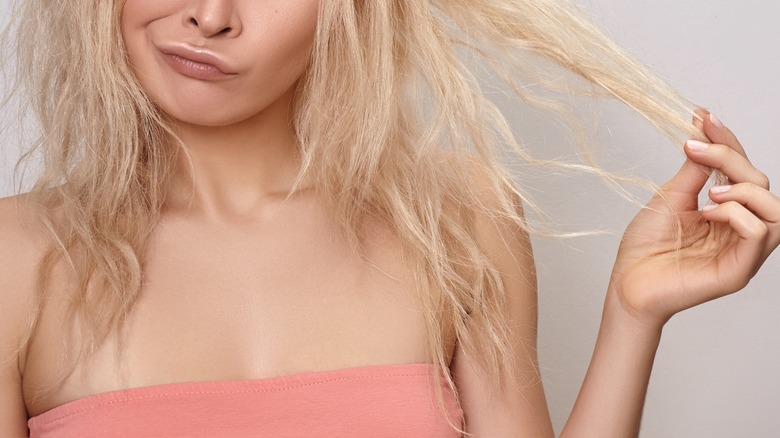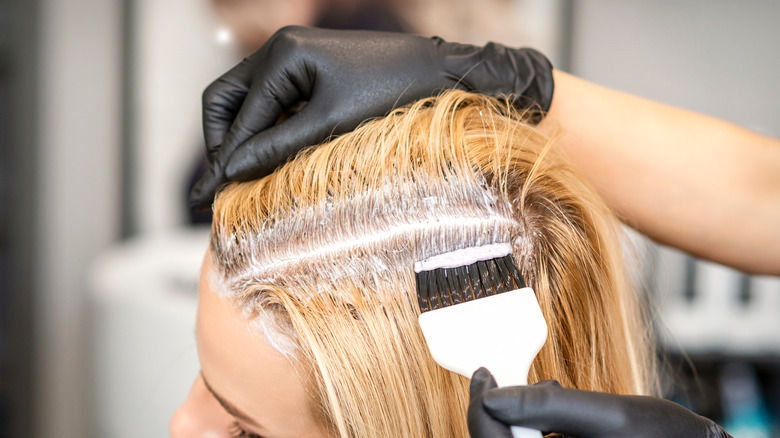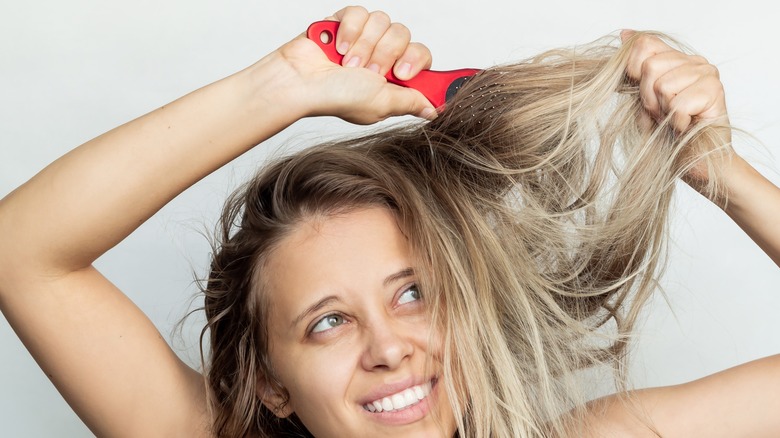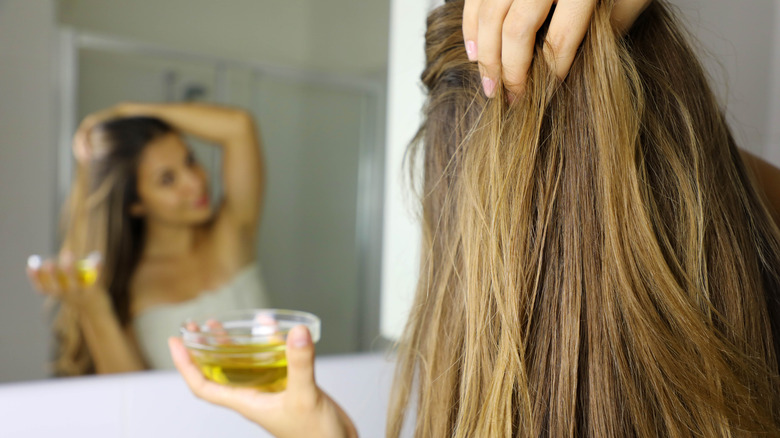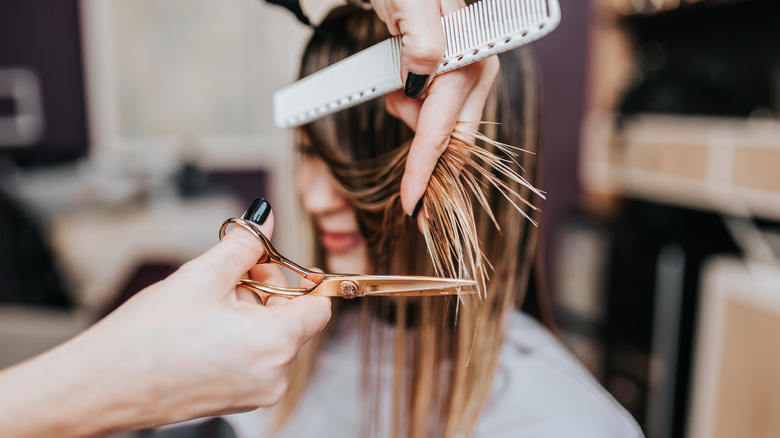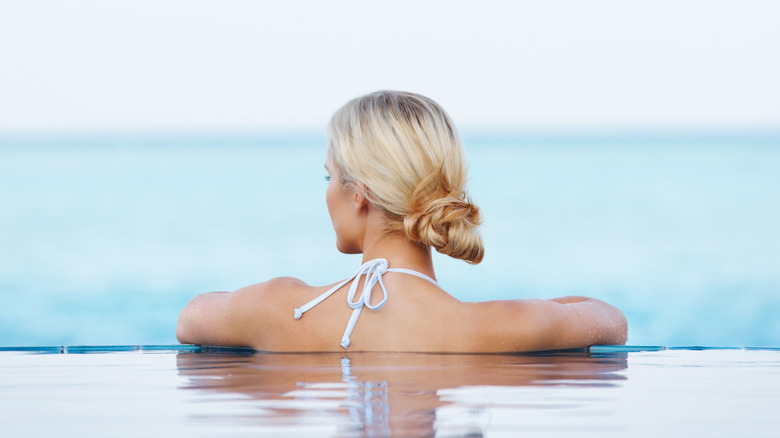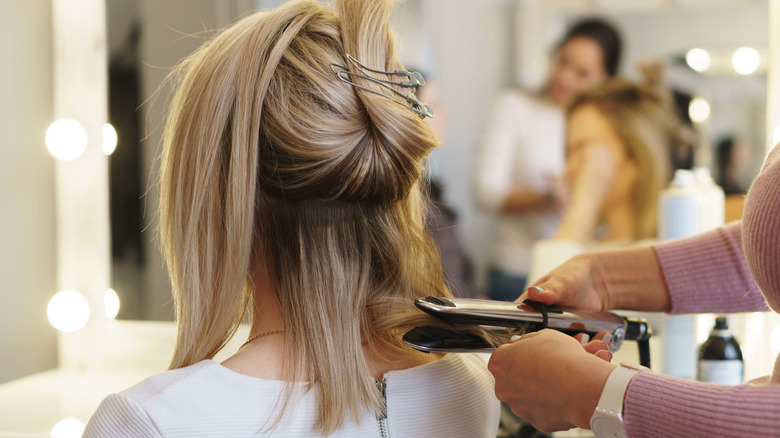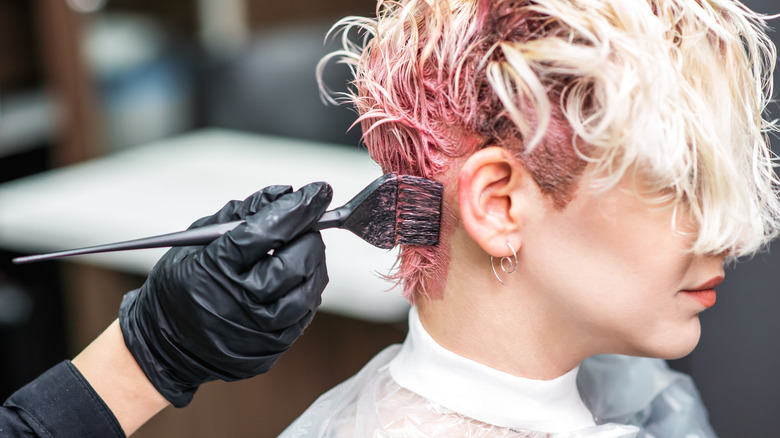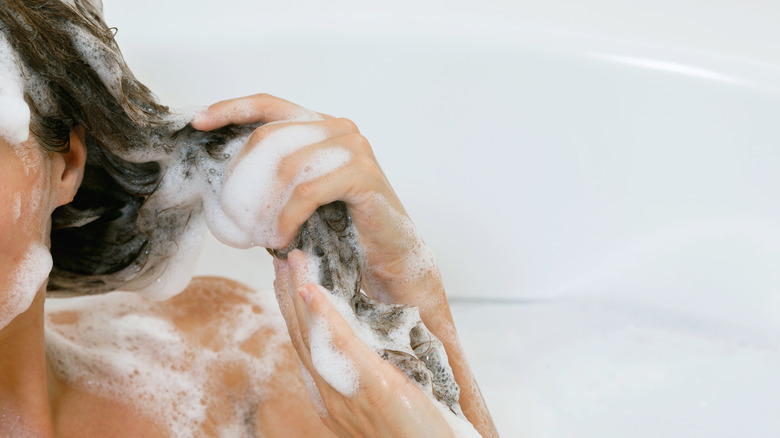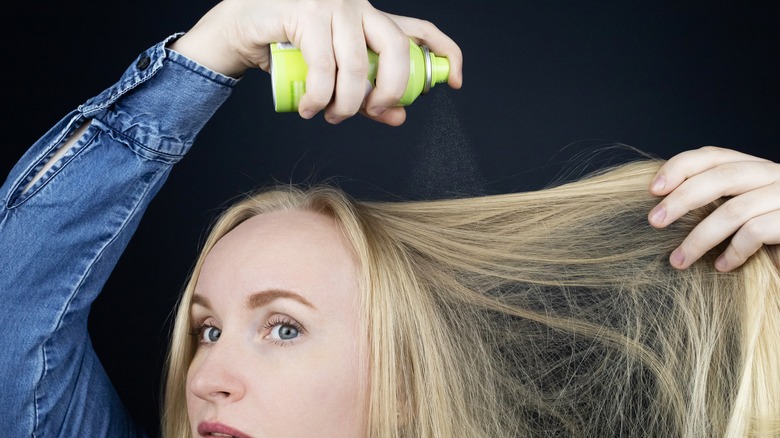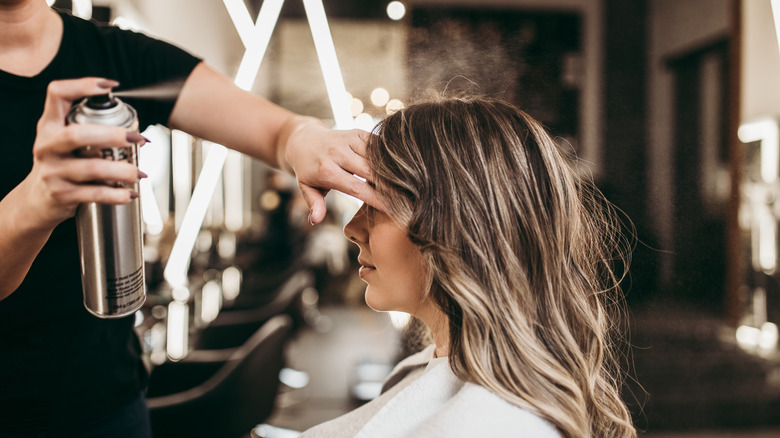Simple Ways To Repair Bleach-Damaged Hair
We may receive a commission on purchases made from links.
Picture this. You've switched out much or all of your virgin hair for the dye of your dreams — think pinks, platinum, or purples. But to look as über cool as you do, you had to pay a price that you realize only weeks later is rather heavy. Hair damage. If you bleached your hair out to shade it anew, the increased frizz or breakage would probably be telling you as much. Damage is an inevitable side-effect of bleaching your hair since it's a process that involves making structural changes to your natural strands. "Having bleached hair is like having a finicky house plant," as expert hairstylist Tim Aylward aptly puts it (via NBC News). It needs intense and daily TLC, especially when it's in crisis. If you don't give it the adequate care it needs, it will lose life. Literally.
Can the damage bleach causes to hair be reversed? Not exactly. Hold on, don't be alarmed, and imagine yourself in every bleach-fail horror tale you've heard. It can't be reversed, but can surely be salvaged. Undergoing a major chop may set things on the right track (somewhat) — as it did for this woman who shaved off all the hair she had been bleaching for two decades to let virgin hair grow in its place. Even better is how, with the right combination of products, salon appointments, diet, and hydration, you can well retain the health of your bold, beautiful, blonde locks. Take down the tips below!
What does bleach do to your hair?
Though the fun of it may not make it seem so, there's a lot of science behind the act of changing your hair color. Bleaching your tresses involves complex chemical changes in the makeup of your strands that are largely irreversible. Darker hair shades are primarily composed of a natural pigment called eumelanin, The Washington Post notes. So when you apply bleach on your hair to go from a dark hue to a lighter one, the process entails breaking down that organic substance in your hair shaft and washing that original pigment out to make the application of a color of your choice possible. "It is impossible to make your hair lighter without the use of a bleaching/oxidizing agent, so no matter what, your hair will reap some type of damaging effects," according to hair expert Robert Dorin (via HuffPost).
While condiments like lemon juice and vinegar are touted as natural DIY hair lighteners, using chemicals to bleach hair almost always commonly involves hydrogen peroxide, the agent that reacts with melanin to strip your hair of its natural color (per ThoughtCo). The alkaline nature of the solution affects the hair shaft and leads to the opening up of the hair cuticle, which lends bleached hair a swollen effect, making it appear more voluminous. Trichologist Dr. David Kingsley explains that the more swollen the hair is, the more vividly a fresh color will reflect on the strands (via Refinery29).
Can bleach-damaged hair be fixed at all?
It's true what they say: beauty comes at a price. Bleaching your hair may keep you looking your trendiest best — think Kardashian-Jenner platinums and blondes — but the procedure to stay in vogue isn't exactly risk-free. Lightening your hair has many side effects, ranging from bleach burns to severely damaged tresses that have no way out but to be chopped off. "You must remember we're using chemicals that can be quite dangerous to the scalp and hair, so this needs to be handled with caution," colorist Hitomi Ikeda warns (per Seventeen). Alongside accidental mishaps, there is the ever-present consequence of chemical damage. This is expected since hair bleach literally recomposes your hair makeup, leaving strands inevitably weaker than before and more prone to falling out (if not cared for well).
This is why professionals recommend being extremely mindful about following best practices when lightening your hair. Platinum prince Zach Mesquit, who is renowned as Wella's CBO (Chief Blonding Officer), explains: "The bleaching process can completely ruin your hair beyond repair when used incorrectly or too quickly" (via Byrdie). And once your mane feels the brunt of bleach, it becomes a herculean task to revive its health (per Hairlust). What if you already have a bleached head that looks like it's irredeemable — what then? If the ship of safe bleaching has sailed, the next ship you can hope to catch is intense haircare that prevents further damage.
Deep conditioning and protein treatments will be your BFFs
These three most important rules to heal bleach-damaged hair: hydrate, hydrate, hydrate! Deep conditioning and leave-in treatments will be your fastest friends on your journey to better hair health, making up the foundation of the rest of your haircare routine. And even professionals can't stress this enough! "Deep conditioners have a high concentration of extremely beneficial ingredients that promote the healthiest hair possible," Insta-favorite stylist Brad Mondo notes (via Marie Claire). Moisture and protein are two fundamental elements all bleach-damaged tresses need and can get from a whole range of hair treatments, from serums to oils and nourishing hair masks. When going for store-bought products, opt for ones specially formulated for color-treated, dry, or damaged hair.
"The ingredients in hair masks are a lot more potent than ingredients in regular conditioners, and their benefits definitely last a lot longer," stylist David Toth shares (per Glamour). A deep treatment once a week will help relax processed hair to a great measure. Here, you can even save a few bucks by turning to homemade hair masks with condiments found in your own pantry — from avocados to honey and rice water rinses (via Healthline). Mondo recommends covering your damp, masked hair with a towel to trap heat that will help penetrate the treatment deeper into the hair shaft. Be careful not to over-condition, though. Post-wash, add a dab of oil to your ends to lock in the moisture!
Watch what's on your plate
What you're feeding yourself matters just as much as what you're feeding your mane when it comes to hair wellness. On the playground that is your hair, protein is the star player. This is because keratin, a protein, is central to skin, nail, and hair health (via Britannica). Very simply, it is the building block of your hair, and getting adequate protein portions into your diet will help in breathing life back into your strands. Dermatologist Nicole Rogers recommends consuming at least 40-50 grams of protein every day, per Bustle. Consider including animal protein like meats and eggs on your plate; salmon, with its omega-3 fatty acids benefits, is an excellent choice. Legumes, seeds, nuts, and lentils are great vegetarian protein options.
In fact, attention to haircare should begin in advance of your bleaching appointment as pre-color prep. "Drink lots of water, and eat fruits and vegetables that are high in water content," advises hair wiz Cassondra Kaeding (via Who What Wear). Long-time members of the bleach brigade swear by clean eating and drinking over two liters of water daily. Some other nutrients that are said to strengthen hair growth include vitamins A, C, and E, zinc, and biotin. While consuming natural food sources is the best way to balance your diet, the benefits of hair growth supplements are also popular among bleach heads. Nutrafol is touted as an effective addition to hair health routines, colorist Bianca Hillier notes (via Yahoo!).
Don't skip haircut appointments
You may have heard horror stories of people having to shave off hair after their bleach experiments went awry. Even pop sensation Zayn Malik's hair didn't stand a chance — "I just shaved my head because I'd bleached it too many times and it was a bit destroyed," he revealed in 2017 after going fully bald (via the Associated Press). So unless you think you can rock a barren-headed look like Malik, don't skip those regular haircut appointments! The general rule of thumb is this: "The less stress you are putting your hair through on a daily basis, the longer you can go between trims," as quoted by celebrity stylist Christine Symonds (per The Zoe Report). Therefore, bleached tresses always in search of extra TLC need a trim at frequent intervals to be in their healthiest possible state.
Pro stylist Flavien Heldt recommends chopping off those pesky fried ends every month (via Vogue). That is, "until you recover the hair quality you want." The focus is not on losing length, but losing damage. Chemically processed hair is more vulnerable to breakage, tangles, brittleness, and frizz, given that bleaching procedures involve the breakdown of proteins in your strands that alter the texture of your hair. And nobody wants to see fistfuls of hair every time they wash or brush! As Redken's Tracey Cunningham suggests, the moment you notice exaggerated damage through tangles or breakage, you know it's time for a snip session (via Refinery29).
Beware of swimming pools
Your neighborhood swimming pool is full of chemicals that won't be kind to your bleached tresses. Just ask Ryan Lochte. In 2016, the Olympic swimming champ's dyed blue platinum crop turned green, a look he had to live with through his medal-winning moment at the games in Rio (via Time). If you're hoping to avoid a similar malfunction, know that pools are unfortunately off-limits unless you slather your peroxide strands with protective products! Pool water is injected with chlorine, which is by nature a chemical bleach itself and is best avoided from contact with lightened hair. Not only will chlorine "cause the color to oxidize quickly" for people with dyed hair, per celebrity stylist Clariss Rubenstein, but it can also dehydrate your hair and leave it looking limp (via Byrdie).
To dive a little deeper — the actual culprit in the water is actually copper, the particles of which oxidize and cause the hair to turn minty, according to hair expert Elvin Arvelo (via Self). The more damaged your hair is, the greater the effect of chlorine will be on it. Pre-plunge, make sure to coat your hair with water and a good leave-in conditioner — something Lochte was unable to do, per his colorist (via Allure) — before covering it with a swimming cap. Rinse your hair well afterward with a clarifying shampoo. Even better: if you're trying to recover lost hair health, it would be wise to briefly give your splash sessions a miss.
From styling tools to the sun, direct heat is a no-no
Bleaching is stressful for your hair. We want to keep the strands from stressing out further to protect them from more damage than necessary. Laying off heat is one way to do that. You may be tempted to tame those frizzy flyaways with a flatiron or curling wand — but keep that apparatus back down. Heat styling is no friend to bleach-damaged hair. Celebrity colorist Cassondra Kaeding confirms that "using hot tools on damaged hair will cause more breakage" (via Who What Wear). A first-person account from a blonde veteran and client of Kaeding's relates that even blowdryers were a no-no for her for months after a major bleach fail experience. We don't want the double jeopardy of bleach and heat damage!
The same applies to direct heat from the sun, which experts recommend you should beware of for at least two weeks after a fresh bleach (via Byrdie). With the hazards of sun exposure increasingly coming to light, there is cause to be wary of its harmful effects on hair. According to Dyson's Veronica Alanis, sun heat doesn't just destroy hair pigments but also messes with keratin proteins in your strands (via NDTV). Don't forget your hat when stepping out on a sunny day. And, if you absolutely have to, use heat protectants all over your strands before reaching out for that flatiron. Remember, your tresses will be most thankful if you just let them breathe.
Avoid overprocessing your hair and take breaks
Ironically, a hair-of-the-dog approach doesn't work when it comes to hair. Over-processing your hair with chemical procedures to repair bleached hair isn't the best idea. The tress mess you see on your head in the mirror every morning may give you an itch to up and do something about it, but relying on more chemicals to reverse the damage would be like shaking hands with the enemy. "Take a break so your hair doesn't break," celebrity stylist Rita Hazan sagely advises (via Hello Giggles). In just one of the many cautionary horror tales about over-processing, a woman related how chunks of her hair literally broke off after bleaching at short intervals, and she had to wait months before her strands could come near color again (per Allure).
"Overlapping the bleach is the most common reason for disastrous damage," Hollywood colorist Tabitha Dueñas maintains (via Byrdie). The signs of spotting damaged hair will be evident enough. Aside from looking frizzy, your hair will feel super dry and brittle to the touch, lackluster, and be prone to tangles, according to hair expert Melissa Greco, who recommends removing the overuse of stressors like shampoos and styling tools from your routine (via Elle). The six- to eight-week mark is usually recommended as the standard between bleaching touch-up appointments. Bleach-damaged hair is super porous and vulnerable, so you'll want to ensure that the correct products are applied correctly.
Don't bathe with hard water
We hate to break it to you, but ... there may be silent hair killers in your shower. Believe it or not, bathing with the wrong kind of water can wreak even more havoc with chemically altered hair. Unfiltered or hard water is torture for your bleached tresses — it's right there in the name — and, as expert Jamie Garland said, "is a colorist's worst nightmare" (via Stylecaster). Hard water contains all kinds of mineral contaminations, including iron, magnesium, and lead, deposits of which can lead to buildup and damage in the long run. It's unhealthy for everyone, more so for people with colored hair. As noted by trichologist Bridgette Hill, dyed hair is highly porous owing to the opening of the hair cuticle during bleaching processes, which allows for minerals in hard water to penetrate deeper into the hair shaft (via Byrdie).
Not only would hard water leave your hair feeling unclean, it could end up stripping your strands of color and making them brittle, dermatologist Dr. Francesca Fusco cautions (per InStyle). A good clarifying shampoo can stand out as a temporary fix, not a long-term solution. If you're choosing products carefully for color-treated hair, you must extend the same judiciousness to your water by installing a trusty water filter in your shower. Take blonde-brunette beauty Sydney Sweeney's word for it — the "Euphoria" star testified that adding a shower filter to her haircare routine changed everything (via Bustle).
Choose your hair products wisely
Haircare isn't just a task anymore. It's a whole job. From scanning through the ingredients list on a hairspray bottle to knowing exactly how to apply it to your strands for maximum results, there's a whole checklist to maintain when choosing the right products. More so for bleach-damaged hair that is thirsty for intense nourishment. According to eminent colorist Bianca Hillier (per Real Simple), piling on hair conditioners is not enough. Aside from the risk of product overuse that can weigh your hair down, investing in vague treatments won't target the damage you want to eliminate. Instead, experts across the board recommend bond-building treatments that go deep into your strands to repair the chemical havoc there.
Coloring wiz Matt Rez explains that bleaching "puts stress on the disulfide bonds within the keratin protein structure of the hair," which bond-builders seek to strengthen (via HuffPost). Olaplex and Redken have holy grail haircare products that claim to do just that for processed hair. Blonde beauties also swear by purple shampoos and conditioners, which help preserve the brightness of bleached hair by neutralizing its brassiness. Note, however, that purple shampoos work their magic best on lighter hair shades and may affect pigments in darker-dyed hair, according to GQ. While prudence is advisable when using purple products, given their tendency to dry out hair with overuse, hairstylist Kristen Shaw concludes that they offer good "balance in between visits to the salon" (via NBC News).
Seek out help from a hair specialist
Leave damage control to the professionals. If you don't like how your peroxide-treated hair looks or feels, don't reach for a fresh bottle of dye or the scissors. A hair specialist is better equipped for disaster management when things come to a head with your bleach experiments. "A professional has the education, experience and knowledge about hair texture and hair types and what will work best for your specific needs," colorist Georges Rues rightly advises (per Vegamour). Whether it's recommending a bond repair treatment or a keratin procedure to restore hair health, a salon specialist will heal your tresses better than any DIY quick fix ever will. That said, it's equally important that you do some groundwork before giving your hair to any hairstylist's hand.
"The biggest, most unfortunate mistake I see with my guests when they sit in my chair, is a previous colorist overlapping damaged lightened hair," pro stylist Hannah Nishimoto reveals (via Hair.com). Sure, consulting a good colorist might have you burning a few extra bucks. But for the sake of your burned hair ... Be sure that the salon you visit ensures safe color practices, avoids train-wreck methods like double bleaching and uses the right products. There, that's half your battle won. The other half depends on you, as The New Yorker puts it. Be thorough with haircare at home — eat, condition, and destress well. Oh, and rock your locks like the bleached bombshell you are!
